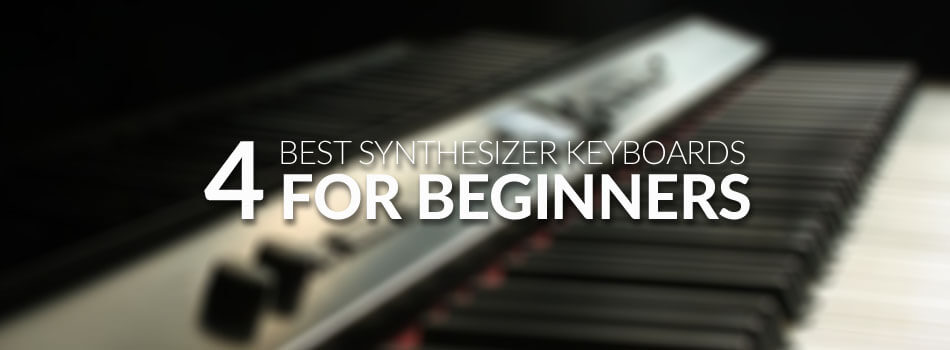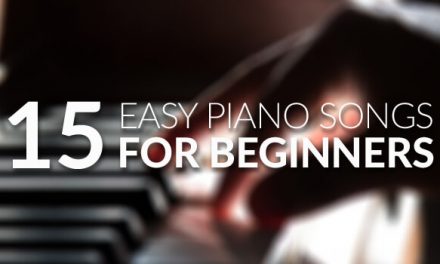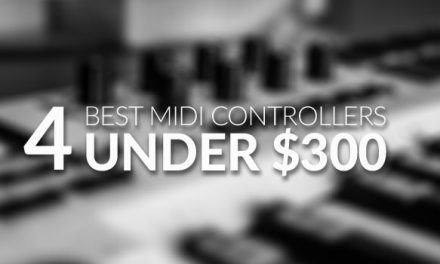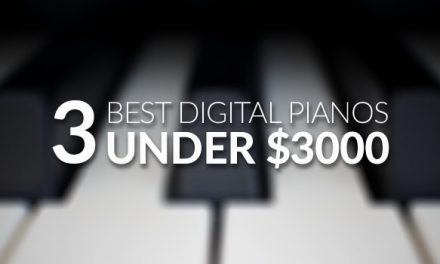Introduction: A Foreword about the Best Synthesizer Keyboards for Beginners
One can hardly imagine any modern composition without at least some synth sounds. Synthesizers, especially Keyboard Synthesizers, have revolutionized the contemporary musical landscape. Be it old-school disco or the newest trap trends, hundreds of musical genres and sub-genres use synthesizers.
No matter if you’re just getting into electronic music or are an experienced pianist who wants to get into the world of computer-based music, we’ve got you covered – and today, we’re presenting our picks of the best synthesizer keyboards for beginners.

QUICK RUNDOWN
If you are in a hurry these are our top picks:
#1 Yamaha MX49  Editor Rating Read Full Review |
|
#2 Korg Monologue Monophonic Analog Synthesizer  Editor Rating Read Full Review |
|
#3 Arturia MicroBrute Analog Synthesizer  Editor Rating Read Full Review |
|
#4 Casio CTK2400 61- Key Portable Keyboard  Editor Rating Read Full Review |
|
Last Updated on
Table of Contents
Before we start the countdown, we are going to briefly explain the differences between digital pianos, MIDI controllers and synthesizers, as all of these most often use a keyboard-layout, but are pretty much different things.
Without any further delays, let’s start the show!
Buying Guide:
The difference between Keyboards, Digital Pianos, MIDI controllers and Synthesizers.
Keeping it at it’s most basic level, the word keyboard refers only to the famous layout of the keys on the piano. That means that a MIDI controller and a Synthesizer can come in a keyboard variation and a different type of configuration that doesn’t use a keyboard for the input.

Digital pianos always come with a keyboard, of course, as they are mainly meant to simulate acoustic pianos, harpsichords and organs, while additional features for modern musical styles are often in the background or don’t exist at all. MIDI controllers and Synthesizers can simulate acoustic pianos, but their main target audience is electronica musicians who want to experiment with samples, synth sounds and effects.
A MIDI controller usually doesn’t produce sound on its own. You need to buy additional software and you can use it with different types of software with ease. Often you get some free music software with your MIDI controller, as well. The thing is, the software is stored on your PC most of the time.
Now, a synthesizer often comes with its own, built-in sounds. If you want to use a synthesizer as a MIDI controller for different software on your PC, you will have to find a workaround. In a rock and roll setting, keyboards often refer to synthesizer keyboards.
If you are still confused about what you need to play synthesizer keyboards, here is a video about a very standard setup for synth keyboards:
Basically, whatever synthesizer you buy, you will have to spend quite a lot of time figuring out all of the functions and tone settings. As a beginner, you should try finding something simple with intuitive controls and an easy setup. In this case, less is definitely more.
So, what keyboard synthesizer should you buy? Let’s find out!
BEST SYNTHESIZER FOR BEGINNERS REVIEWS

Overview:
Over 1000 Sounds from the MOTIF Series
Realistic acoustic sounds: piano, electric piano, strings and drums
Complex 8 element synth sounds
VCM Effects which simulate vintage effectors at the circuit level
Easy Split /Layer Performance Mode for Instant Inspiration
16-Part Multi Timbral and 128-note Polyphony
Bi-directional USB Audio/MIDI Interfacing
Description:
For beginners, we recommend the MX49 with its 49 keys, although bigger models are available for a higher price. The affordable price of the MX49 doesn’t come from any lack of features or a low quality, but only because of the somewhat smaller-sized keyboard, which is often preferred by traveling musicians anyway.
The countless features, including extensive hands-on controls for vsts and daws, a complete suite of music production software and a lightweight design, make this Yamaha keyboard a reliable instrument that is definitely worth the investment even at a beginner level of playing.
For more about Yamaha MX49, check out customer reviews on Amazon.
- Sounds 92%
- Features 94%
- Price 92%
THINGS WE LIKED
- Great for the stage and studio alike
- Over 1000 MOTIF Voices
- Beginner-friendly size and design
THINGS WE DIDN'T LIKE
- Has layer and split functions, but lacks a dual mode
Overview:
Rich bass and cutting leads
LFO capabilities expanded with higher rates and deeper modulation
16 step buttons for faster real-time step edits
Push button + turn knob for “parameter lock” style motion sequencing
Fully programmable
MIDI, USB MIDI, and Audio Sync for all types of in-studio and live connectivity
Durable aluminum top panel, chassis-mounted pots, rubber-coated knobs, and wooden backpanel
Description:
The Korg Monologue lies on the border between professional instruments and high-end entry level keyboards. The monophonic structure makes it appropriate for beginners, but limits the expressive possibilities. We recommend using this synth only if you are already proficient with a piano as you are not going to be able to fully master all keyboard-techniques with a monophonic instrument.
That being said, the Korg Monologue is a fully programmable analog synth that builds up on the success of the Minilogue. The Monologue does both Hard Sync and Ring Mod, which gives it a very broad sonic palette to work from. Waveshaping on both oscillators can also have a big influence on how cross-modulation sounds, making it one of the best monophonic synths on the market.
For more about Korg Monologue Monophonic, check out customer reviews on Amazon.
- Sounds 95%
- Features 90%
- Price 90%
THINGS WE LIKED
- Great quality for a fair price
- Responsive and sensitive knobs
- Unique size of keys that’s comfortable to play
THINGS WE DIDN'T LIKE
- Standard pitch bend and mod wheels would be better
Overview:
100% Analog Monophonic Synthesizer with a voltage-controlled oscillator
25-Note Mini Keyboard with an Overtone sub/5th generator
Mixable Multi-Wave Oscillator
Steiner-Parker Multimode Filter
8 memories, up to 64 steps per memory
Step Sequencer is a source of fresh ideas and endless inspiration
Modulation Matrix gives you semi-modular flexibility
Description:
The MicroBrute is small but powerful. It is another monophonic synth, but that doesn’t get in the way of powerful sounds on this synth. Brute Factor lets you dial in dangerous distortion, which enables crazy lead plays.
The small keys will require some getting-used-to if you’re a trained pianist, but it’s definitely worth the effort. You will be able to keep the MicroBrute for a very long time and use it alongside with your other synths, even if you expand your gear. The Arturia MicroBrute Analog Synthesizer may be minuscule, but it delivers a staggering range of sonic possibilities, especially considering the price.
For more about the Arturia MicroBrute, check out customer reviews on Amazon.
- Sounds 90%
- Features 95%
- Price 95%
THINGS WE LIKED
- Tons of distortion
- Waveshapers modify and animate your sounds, for a broad palette of sonic possibilities
- A well-implemented step sequencer
THINGS WE DIDN'T LIKE
- Not quite as sturdy as other synths on the market
Overview:
61 standard-size keys
Maximum Polyphony of 48 notes GM level 1 Standard MIDI
400 Built-in Tones
150 Built-in rhythms
Lesson Function for beginners Auto Accompaniment
Description:
The Casio CTK 2400 is definitely aimed at beginners and people on a tighter budget. You shouldn’t expect a performance instrument for this price, but it is still a useful learning tool as it is a portable keyboard with a lot of functions.
The keys feel quite good considering the low price-point. The auto accompaniment and the song bank will make learning about synths and music an easy task, but keep in mind that you will probably have to upgrade to a better instrument as you progress.
For more about the Casio CTK 2400, check out customer reviews on Amazon.
- Sounds 84%
- Features 86%
- Price 98%
THINGS WE LIKED
- Beginner-friendly design
- Most affordable synth on the market A well-implemented step sequencer
- Can sound fine with decent speakers
THINGS WE DIDN'T LIKE
- Low-end product that is not as durable as higher-end instruments
CONCLUSION
Synths can be quite different one from another, so make sure to watch a lot of tutorials and set-up videos to make sure that you can use what you’re getting. As a beginner, you should definitely consult a professional to make sure that you’re getting the right setup, but in the worst case, register to a forum and ask everything there.
Your final synth sound will definitely depend on the speakers you use, as well. Make sure to have some good speakers or amps ready to use in combination with your synth.
If you liked this article, you may want to check out our other articles on keyboards, MIDI controllers and digital pianos. Make sure to tell us in the comments what keyboard synthesizer you plan to start with!







